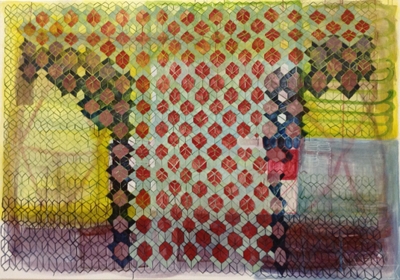
In my art I use a lot of geometric shapes and patterns. Mathematics is a great inspiration for me. It fascinates me that the universe is mathematical and that all matter can be described as numbers, the relationship between numbers and the patterns they form together. Numbers not only represent quantities, but they also describe shapes such as a point or circle, lines, triangles, squares and so on. When these shapes connect with each other, all kinds of patterns appear that can vary endlessly.
In this medieval painting God is represented als the supreme geometer.
The numbers from one to ten can be considered the alphabet by which the universe is written. The numbers are the foundation for designs found throughout the universe, beginning with the smallest particles to the largest galactic clusters. Crystals, plants, fruits and vegetables, weather patterns and the bodies of humans and animals are made up of small patterns that are part of a larger design. There are patterns formed as spirals, these can be found in hurricanes, atoms, pine cones, shells, galaxies and whirlwinds.

Other examples include concentric circles in water, circles that stars write around the pole star over time, and dorodango; a Japanese technique of making a perfect round ball out of mud with your hands. This are examples of the number one. The petals of the Crown of Thorns, mitosis, maple seed and symmetry are examples of number two. Number three can be found in fruits and vegetables such as cucumber and melon. Dehydrated earth breaks apart into squares, salt crystals are shaped like cubes and the flower of the Lunaria for example, has four petals.

Number five is a special number and represents growth and the golden section. The golden ratio can be found in the five-pointed star and it can be used as a tool to find the golden ratio in nature. In the human body, you can find the golden ratio in the division of the forearm with the hand, subdivisions in the face, the finger bones, and so on. The distances between the planets are also divided into the golden section. The golden section also has a relationship to Fibonacci’s spiral in the aforementioned spirals in shells, galaxies and pine cones.

Number six can be seen perfectly in the honeycomb and in the amazing and unique shapes of snowflakes. You can count seven colors in a rainbow and the octave is divided into seven notes. A spider has eight legs, bloodroot has eight petals and there are sponges in the shape of an octagon. There are few nine-fold shapes found in nature; nine is the principle of completion. It takes nine months of development before we are born into this world. We have ten fingers and ten toes, a squid has ten legs and a passion flower has ten petals.
These examples about how nature expresses itself in this genius and poetic way inspires me. By drawing and painting these shapes of numbers, I try to gain a better understanding of the universe and why I am in it.
